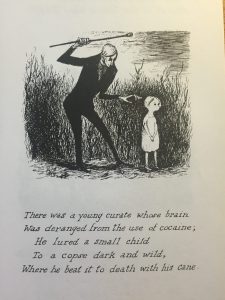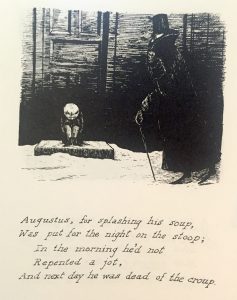“The Listing Attic” is one of my favorite sections from Amphigorey. It’s another example of Gorey putting a dark spin on usually non-dark forms of writing (e.g., children’s books, panoramic postcards). In this case, he plays around with limericks, which are usually humorous, lighthearted, and sometimes nonsensical. Weirdly, Ithink Gorey doesn’t necessarily abandon these qualities in his works — he just has a different take on them. I feel like I uncomfortably laugh at his limericks because the humor is unexpected and points out absurd, often frustrating situations in life. My thought process when I see some of his works in “The Listing Attic” and other sections is: “Oh my gosh, this should not be happening, but it is, and it just goes to show you how ridiculous life — or people — can be sometimes. I should try not being so serious all the time, because bad stuff is going to happen either way, and it’s pretty tiring to be serious over stuff you might not have control over.” (Although, this is not to say that we should just laugh at everything, I still think there is a time and place for everything, Gorey’s works included. For example, I wouldn’t show these to someone who is grieving a death). Here are two examples that prompted these thoughts / made me chuckle uncomfortably:
I’m also curious about Gorey’s process behind “The Listing Attic,” as it seems like one of the few sections that reads more like a collection rather than a story. Did he want these limericks in a particular sequence, or were they ordered chronologically?
I wish I knew what the French limericks said as well, or why he decided to use French specifically for those images — I wonder what kind of added a cultural context or meaning the language offered. Although, maybe using French wasn’t so conscious of a decision.
The origins of the title are also interesting to think about. Perhaps “listing” is a reference to how it seems like he is listing all these different situations dealing with people who are forgotten, shunned, punished, etc. And given that, maybe “attic” goes well in the title because attics are usually hidden away or forgotten about when people visit a home.









